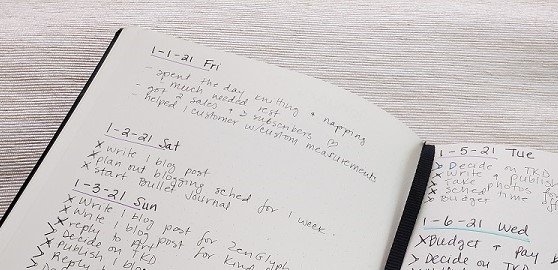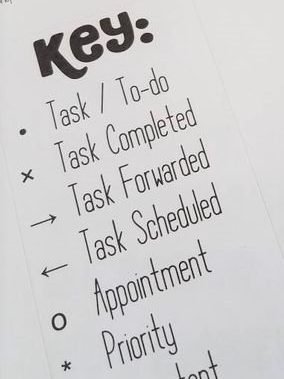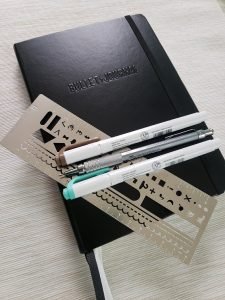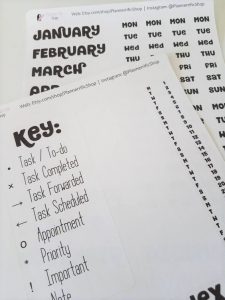I feel like ever since it came out, Bullet Journaling (and its beautiful images) has been all the rage in planner community and on social media. It has become such a part of our life that we throw its name around without stopping to explain what it is to those that hear about it for the first time. So, what is Bullet Journaling and why it’s called that?
Bullet Journaling comes from bullet points that are used as a part of this journaling system. Designed for a quick note-taking, the system uses the bullet symbols to outline every item in your daily list. Various bullets are used to symbolize and give added meaning to the bulleted list.
There are a variety of types of bullets, each designated for a different type of note or task or piece of information.
The beauty of the Bullet Journal is that it is completely customized to the person that uses it. It uses an empty dot-grid notebook as its base and every day, week, month or year in it is drawn up, written, created from scratch as you go.
Because of that, there is no wasted space in the journal and every day or week or month you can redesign the way you use the system. Even bullets, though suggested for every occasion, can be changed, updated and replaced to something else that makes more sense to the user of the journal.
What are the bullets in Bullet Journal
The original Bullet Journal system comes with a small set of bullets and signifiers. Ryder Carroll created symbols that made sense to him and uses them consistently, that what makes the system work.
The bullets in the system are:
A dot – to mark a task
An X – to mark the task that has been done
An open circle (or an O) – to mark an event
A dash – to mark a note
Less than sign – to move the tasks onto the calendar for future dates
More than sign – to move the tasks to the next day
The signifiers in the system are:
An asterisk – to mark something important
An exclamation point – to mark something inspirational

These are the bullets that everyone starts with and as they get more and more used to the system, they can change them so something that works better in their own personal world.
For example, for me an exclamation point makes more sense as something important and the asterisk is more like a note, while dash is more like a subtask.
As you use the Bullet Journal, you might stick to the original design and the bullets, or change them up based on your liking. Bullet Journal and the bullets were intended to be adopted to the journaler’s preferences.
Where did Bullet Journaling originate?
The Bullet Journal and the Bullet Journal Method were created by Ryder Carroll who came up with the system and its design as a coping mechanism for his learning disability and to stay organized in the way that made sense for his mind.
One day he shared his system with a co-worker who them encouraged him to share it with others for how simple, elegant and efficient it was
What does it mean to Bullet Journal?
To bullet journal is to use the Bullet Journal Method in a dot grid notebook to organize your tasks and to-do’s, note what’s going on in your life, become more aware of where your time is spent and become more mindful and aware.
Bullet Journal system uses the Rapid Logging, a system of taking quick, short notes preceded by symbols, or bullets, to create bulleted notes to organized the chaos that is our life.
The bullets serve as a shorthand for different things that the journaler is logging and help to streamline all the tasks, events, notes and other happenings in one’s life.
When you are bullet journaling, on a daily basis you would create a daily entry, and using the bullets denote each thing you enter for the day.
If you have some tasks you need to be done, you would mark each of them is a dot (a bullet for a task) and write out in a short form (or Rapid Log) when that item is.
Tasks are things like changing an oil in a car, paying bills, buying groceries, submitting a manuscript for a book, writing a blog post or posting it.
If you have any events for that day, you would put an open circle before that item and then write out what it was. Events can be things like birthday, movie date, a doctor’s appointment, travel.
If you had some notes you wanted to take throughout the day (or as a part of doing the tasks or going to events), you would enter them by placing a dash in the beginning of the line and then writing out (again a short format) the note. This same bullet symbol is used for ideas as well.

If the tasks aren’t completed on the day you intended to do them you would use the more than and less than signs to mark the tasks that were moved to the farther future (think month or more away) or to the next day or two respectively.
And, at last, to use the signifiers, you could put a star before any of the bullets above to mark that it was an important task/event/note or you could put the exclamation mark in front of something that was inspirational (usually before a note).
On a daily basis, all the bullets can be mixed and matched to accommodate everything that happens that day.
Depending on what the day holds you might end up with nothing but tasks (dots) if you had “crush it!” kind of a day or you might have nothing but notes if you has a reflective, “stay at home whole day and ponder” day.
Bullets are amazing because they tell you what you have going on that day without reading into every item.
Customizing your bullets and signifiers
The best thing about the Bullet Journals is that you can customize them any way you want and make them work for you.

In the classic BuJo, Ryder Carroll came up with the set of bullets and signifiers to represent certain things (see above), but he himself said that you don’t have to use the ones that he came up.
Since the bullets and the signifiers are so important to Bullet Journaling and basically make it the “bullet” journaling, having the bullets and signifiers that are meaningful to you is pretty important.
To create your own bullets, you can start with using the ones that come with the classic method and start swapping them one by one as you find something else working better. As in example above, I swapped the * that Ryder uses for Priority with an ! which is more meaningful to me in this role.

You can run into the same issue where you feel that an actually arrow works better for you to represent moving the task to next day than “more than” symbol does.
And you don’t have to stick to the symbols we usually find on our keyboards – it’s a handwritten journal after all. You can use your bullet symbol not just represent certain things in your journal, but also jazz it up and make it more exciting.
As long as you use a symbol consistently and it’s meaningful to you, you can use basically anything.
You can use a doodle of a telephone for your scheduled phone calls, or an airplane for travel (especially when you travel a lot). You can used a tiny shopping cart for when you need to go grocery shopping or a tiny hanger when you need to pick up or drop off the dry-clean.

If you don’t feel like you are a doodling wiz, do not fear! There are amazing stencil rulers out there for Bullet Journals and otherwise that have a ton of cute symbols on them you can use – all you need is to trace them in your journal! You can get them on Amazon or even on Etsy.
You can also use the color coding together with your bullets to make it more meaningful or make it really stand out (like using red ! for all really important things vs regular black ink ! for medium importance tasks).
Once you settle on which bullet symbols you are using for which purpose, record them on your Key page. You can read more about the Key bullet journal page here.




